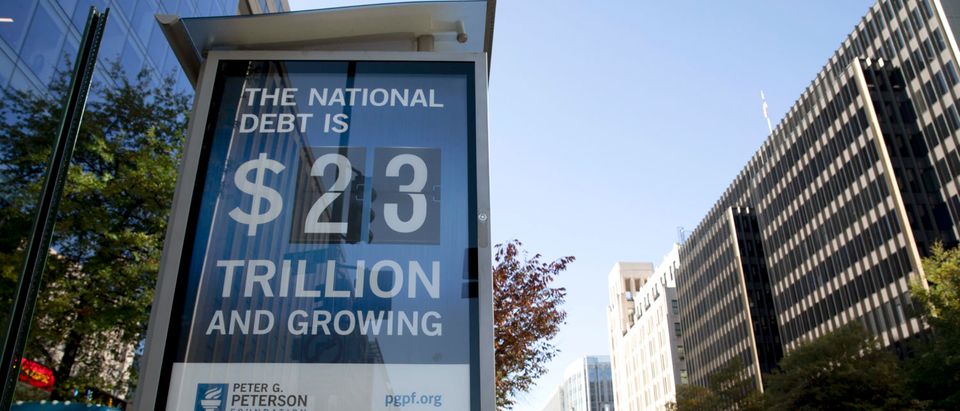Editor’s note: We endeavor to bring you the top voices on current events representing a range of perspectives. Below is a column arguing that the national debt and growing budget deficits pose a significant risk to America’s future financial stability. You can find a counterpoint here, where FreedomWorks Vice President John Tamny argues that budget deficits and the national debt are ultimately not a huge problem — government spending is.
The ancient Greek Sorites paradox asks — Would adding just one grain of sand to a pile of 9,999 grains finally make it a pile? America faces a similar problem. When will the national debt become a pile, or, more acutely, when will it be a problem that must be addressed?
Not long ago, the Republican Party claimed to believe the national debt was an urgent problem. The Tea Party urged Republicans to oppose federal spending during much of the Obama administration. And in 2016, then-Republican presidential candidate Donald Trump told the Washington Post, “We’ve got to get rid of the $19 trillion in debt.” Trump promised he could “fairly quickly” eliminate the national debt “over a period of eight years.”
Instead, the national debt grew quickly under Trump — it’s $25 trillion and now really exploding as lawmakers push stimulus bills aimed at limiting the impacts of the coronavirus pandemic. Congress recently passed, and Trump signed, the largest spending bill in history, the $2.3 trillion the Coronavirus Aid, Relief, and Economic Security (CARES) Act. The Congressional Budget Office (CBO) recently estimated that the U.S. federal deficit will be $3.7 trillion in 2020 plus another $2.1 trillion in 2021, piling on more debt. “Federal debt held by the public would be 101 percent of GDP by the end of fiscal year 2020 and would grow to 108 percent of GDP at the end of 2021,” the CBO found.
“The gargantuan federal bailout that just passed over $2 trillion brings us closer and closer to a point of no return,” Sen. Rand Paul (R-KY) said. “A point at which the world loses confidence in the dollar. A point at which our debt becomes an existential threat to our security.”
While there may not be a precise answer to the question of when this debt becomes an existential problem, there are obvious problems with the notion that America can perpetually run budget deficits and add to its national debt without consequence. Debt requires repayment in the form of interest payments, which can be represented as a percentage of total spending at any given point in time.
In the long-term, the total spending on interest payments on the national debt will become higher than future budgets can afford. Future budgets will have to account for higher interest payments as a percentage of total spending, and these interest payments will eventually crowd out other kinds of spending. Add in the growing costs of Medicare and Social Security for an aging population, and there are scenarios where you could see the country’s debt and unfunded liabilities potentially trigger a default.
Some will argue that the Federal Reserve could simply continue to expand its assets to fund the government as interest payments and debt expand. The Federal Reserve currently holds a historically high $4 trillion in US treasuries. Ratcheting up Federal Reserve assets to those levels would undoubtedly risk runaway inflation as it would require an exponential expansion of assets equaling an unprecedented expansion of the money supply. Critics say Fed actions and rising debt and deficits haven’t triggered inflation over the last decade, but saying something hasn’t happened is far different than saying it will never happen. And worryingly, if the US ever defaulted on a payment to the Federal Reserve, the Fed’s balance sheet would be rendered meaningless if its largest debtor could not pay and a global financial collapse would likely ensue.
As Sorites once noted, one can add many grains of sand to the pile without passing a specific point where you recognize that it is indeed a “pile.” Similarly, lawmakers and taxpayers must recognize that there is not going to be one magic calculable moment or a defining point where the pile of national debt will suddenly appear “too large.”
Yet, sheer logic and the mathematics of finance show that it is nonsensical to suggest a limitless borrowing capacity on the economy. At a certain point, creditors are owed their money. But the implicit and contradictory idea behind limitless debt is that some creditor never gets paid back — America can borrow from a well of money that is infinite in depth and never pay it back. The 20th century witnessed many economies around the world try to print money as their way out of debt, but inflation was always waiting around the corner to tarnish this idea. The Federal Reserve may be able to continue to plug the gap for an unknown amount of time but at some point, even they will be owed money by the US government and if the tax revenues are not enough to cover all necessary payments plus interest payments, a default will occur and trigger a catastrophic chain of financial events.
In 2017, President Trump was shown charts on the long-term debt and deficit and said, “Yeah, but I won’t be here.”
Trump may not be in the White House when the bill comes due, but today’s young people and the future generations that America is burdening with this debt are going to eventually find out what a pile of debt really is if we keep adding to it.












